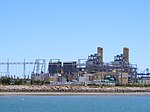Adelaide Dolphin Sanctuary
2005 establishments in AustraliaDolphinsGulf St VincentIUCN Category IVMarine protected areas of South Australia ... and 3 more
Protected areas established in 2005Protected areas in AdelaideUse Australian English from May 2017

Adelaide Dolphin Sanctuary (ADS) is a marine protected area in the Australian state of South Australia located on the east coast of Gulf St Vincent in and adjoining the north-western part of the Adelaide, covering the estuary of the Port River around Port Adelaide and northwards past St Kilda. It was established in 2005 for the protection of a resident population of Indo-Pacific bottlenose dolphins (Tursiops aduncus). The dolphins are keenly watched by dolphin enthusiasts, as well as being a tourist attraction, touted as the only city in the world with wild dolphins living in it.
Excerpt from the Wikipedia article Adelaide Dolphin Sanctuary (License: CC BY-SA 3.0, Authors, Images).Adelaide Dolphin Sanctuary
Geographical coordinates (GPS) Address Website Nearby Places Show on map
Geographical coordinates (GPS)
| Latitude | Longitude |
|---|---|
| N -34.743097222222 ° | E 138.4899 ° |
Address
South Australia
South Australia, Australia
Open on Google Maps







